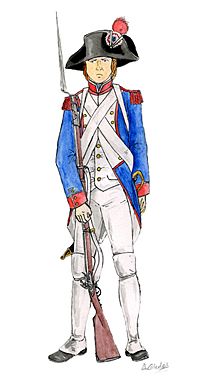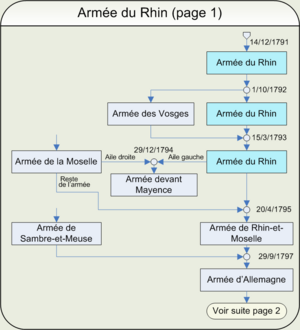Army of the Rhine (1791–1795) facts for kids
Quick facts for kids Army of the Rhine |
|
|---|---|

Fusilier of a French Revolutionary Army
|
|
| Active | 1791–95, 1797–98, 1799–1801 |
| Country | |
| Allegiance | Kingdom of France First Republic |
| March | Chant de guerre pour l'Armée du Rhin |
| Disbanded | 20 April 1795 |
| Commanders | |
| Notable commanders |
Nicolas Luckner Adam Philippe, Comte de Custine |
The Army of the Rhine (in French: Armée du Rhin) was a French army created in December 1791. Its main goal was to bring the ideas of the French Revolution to the German states along the Rhine River.
In its first year (1792), under the command of Adam Philippe Custine, the Army of the Rhine won several important battles. These included victories at Mainz, Frankfurt, and Speyer. Later, the army was reorganized several times. On April 20, 1795, it joined with the Army of the Moselle to form the Army of the Rhine and Moselle.
Contents
What was the Army of the Rhine?
The Army of the Rhine was one of the main French Revolutionary armies. It fought in the Rhineland area, mostly in the Rhine River valley, from 1791 to 1795. When it was first formed on December 14, 1791, it had about 88,390 soldiers.
Its job was to protect France's eastern border. It worked alongside two other armies: the Army of the North and the Army of the Center (which later became the Army of the Moselle). Over time, these armies grew and split into more groups. By April 30, 1793, France had eleven armies protecting its borders.
The Birth of a Famous Song
In the early months of fighting, France didn't win many battles. The Austrian armies and their allies were attacking France's borders. There were many defeats in places like Mons, Tournay, and Bavay.
Meanwhile, cities along the Upper Rhine, especially Strasbourg, felt threatened. Austrian armies were gathering on the other side of the Rhine River. On April 25, 1792, the mayor of Strasbourg, Philippe Friedrich Dietrich, asked a guest named Claude Joseph Rouget de Lisle to write a song. The song was meant to inspire the soldiers and people against the Austrian threat.
That very evening, Rouget de Lisle wrote "Chant de guerre pour l'Armée du Rhin" (which means "War Song for the Army of the Rhine"). He dedicated it to Marshal Nicolas Luckner, a Bavarian who served France. The song quickly became a powerful rallying cry for the Revolution. Its famous lines are: Allons enfants de la Patrie (Arise, children of the Fatherland) and Le jour de gloire est arrivé! (The day of glory has arrived!). This song was later renamed "La Marseillaise" and became France's national anthem.
Victories under General Custine
After Marshal Luckner moved to command the Army of the North, General Custine took over the Army of the Rhine in the spring of 1793. Under his experienced leadership, the army captured several important places along the Rhine. These included Speyer, Mainz, Limburg, and Frankfurt. You can see more details about these battles in the chart below.
How the Army was Reorganized
On December 29, 1794, parts of the Army of the Rhine and the Army of the Moselle combined. They formed the army that was besieging Mainz. The rest of the Army of the Moselle then fully joined with the Army of the Rhine on April 20, 1795. This new combined force was called the Army of the Rhine and Moselle.
Later, on September 29, 1797, this army merged again with the Army of Sambre-et-Meuse. Together, they formed the Army of Germany.
Key Battles of the Army of the Rhine
The Army of the Rhine fought in many important battles between 1792 and 1795. Here are some of the main ones:
| Date | Battle | Victor | Commander |
|---|---|---|---|
| 28 April 1792 | Battle of Porrentruy | France | Adam Philippe Custine |
| 21 October 1792 | 1st Mainz | French | Custine |
| 30 September 1792 | Capture of Speyer | French | Custine |
| 21 October 1792 | Capture of Frankfurt | French | Custine |
| 10 November 1792 | Limburg | French | Custine, Houchard commanding the advanced guard. |
| 2 December 1792 | Frankfurt am Main | Coalition | Custine, GdB van Helden commanding the garrison force |
| 14 April–23 July 1793 | 2nd Mainz | Coalition | Alexandre de Beauharnais |
| 13 October 1793 | 1st Wissembourg | Coalition | Jean Pascal Carlenc |
| 20 August–23 December 1793 | Landau | French | Louis Lazare Hoche (Army of the Moselle) Jean-Charles Pichegru (Army of the Rhine) |
| 18 November–22 December 1793 | Haguenau | French | Pichegru |
| 18–22 December 1793 | Fröschwiller | French | Hoche |
| 26–29 December 1793 | 2nd Wissembourg | French | Hoche and Pichegru |
| 23 May 1794 | 2nd Kaiserslautern | Prussian-Saxon | Claude Ignace François Michaud |
| 23 May 1794 | Battle of Schifferstadt | French | Michaud |
| 12–13 July 1794 | Schänzel | French | Laurent de Gouvion Saint-Cyr |
| 17–20 September 1794 | 3rd Kaiserslautern | Prussian-Saxon | François Ignace Schaal |
| 25 December 1794 | Battle of Mannheim bridge | French | Martial Vachot |
Who Commanded the Army of the Rhine?
The leadership of the Army of the Rhine changed often. This showed how unstable the French Revolutionary governments were, especially from 1791 to 1794. Some generals who commanded the army during these years faced severe consequences from the government.
| Date | Name |
|---|---|
| 14 December 1791 – 6 May 1792 | Nicolas Luckner |
| 7 May – 20 July 1792 | Alexis Magallon de la Morlière (temporary) |
| 21 July – 25 December 1792 | Armand Louis de Gontaut (also called "Biron") * |
| 26 December 1792 – 14 March 1793, | Étienne Deprez-Crassier, temporary and under Adam Philippe Custine |
| 15 March – 17 May 1793 | Custine, also commander of the Army of the Moselle until April 19; he was removed from command of both armies on July 29, 1793, and executed in August. |
| 18–29 May 1793 | Dominique Diettmann, temporary and under Jean Nicolas Houchard* |
| 30 May – 17 August 1793 | Alexandre de Beauharnais, temporary and under Houchard. |
| 18 August – 29 September 1793 | Charles Hyacinthe Leclerc de Landremont, temporary |
| 30 September – 1 October 1793 | Louis Dominique Munnier (temporary) |
| 2–26 October 1793 | Jean Pascal Raymond Carlenc (temporary) |
| 27 October 1793 – 13 January 1794 | Jean-Charles Pichegru, under Lazare Hoche |
| 14 January 1794 – 10 April 1795 | Claude Ignace François Michaud, with Jean Philippe Raymond Dorsner filling in sometimes |
| 4 December 1794 – 13 February 1795 | Jean-Baptiste Kléber, under the Army of Mainz |
| 14 February – 29 April 1795 | François Ignace Schaal, under the Army of Mainz |
| 11–16 April 1795, | Jean-Baptiste Kléber (temporary) |
| 17–19 April 1795 | Jean-Charles Pichegru, during the joining of the Armies of the Rhine and Moselle |
Other Armies with the Same Name
The name "Army of the Rhine" was used again later in history:
- An army during the Bourbon Restoration (after Napoleon) also had this name.
- In 1815, during the Hundred Days (when Napoleon returned), the V Corps – Armée du Rhin was led by General Jean Rapp. This army fought against Russian and Austrian forces, including the Battle of La Suffel on June 28, 1815.
- The name was also used for French military forces in Germany during the Occupation of the Rhineland (1919–1930), after World War I.
People Connected to the Army of the Rhine
Many notable people served in this army, including:
- General Baraguey d'Hilliers
- General Custine
- Antoine Marie Chamans de Lavalette
- The social thinker Charles Fourier (1794–1795)
- General Victor Claude Alexandre Fanneau de Lahorie
- Jean Théophile Victor Leclerc
- General Louis-Théobald Ihler
- General François-Joseph Offenstein
- Captain Claude Joseph Rouget de Lisle, who wrote La Marseillaise
- General Charles Pichegru
- Balthazar Alexis Henri Schauenburg
See Also


